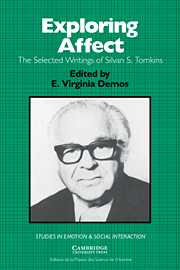Book contents
- Frontmatter
- Contents
- Foreword
- Editor's preface
- List of contributors
- Chronology
- Introduction
- Part I Affect theory
- Introduction
- Selections by Silvan S. Tomkins
- The quest for primary motives: Biography and autobiography of an idea
- Evolution of the affect system
- Role of the specific affects
- Modifications in the theory – 1978
- Part II Affect and ideology
- Introduction
- Selections by Silvan S. Tomkins
- Part III The face of affect
- Introduction
- Selections by Silvan S. Tomkins
- Part IV Script theory: The differential magnification of affect
- Introduction
- Selections by Silvan S. Tomkins
- Part V Human being theory: A foundation for the study of personality
- Introduction
- Selections by Silvan S. Tomkins
- A complete annotated bibliography of Silvan S. Tomkins's writings
- References
- Author index
- Subject index
- Titles in the series
Modifications in the theory – 1978
Published online by Cambridge University Press: 10 November 2010
- Frontmatter
- Contents
- Foreword
- Editor's preface
- List of contributors
- Chronology
- Introduction
- Part I Affect theory
- Introduction
- Selections by Silvan S. Tomkins
- The quest for primary motives: Biography and autobiography of an idea
- Evolution of the affect system
- Role of the specific affects
- Modifications in the theory – 1978
- Part II Affect and ideology
- Introduction
- Selections by Silvan S. Tomkins
- Part III The face of affect
- Introduction
- Selections by Silvan S. Tomkins
- Part IV Script theory: The differential magnification of affect
- Introduction
- Selections by Silvan S. Tomkins
- Part V Human being theory: A foundation for the study of personality
- Introduction
- Selections by Silvan S. Tomkins
- A complete annotated bibliography of Silvan S. Tomkins's writings
- References
- Author index
- Subject index
- Titles in the series
Summary
The theory of affect I first presented at the Fourteenth International Congress of Psychology at Montreal, in 1954, and later expanded in Affect, Imagery, Consciousness in 1962, has since been modified in four essential ways. First, the theory of affect as amplification I now specify as analogic amplification. Second, I believe now that it is the skin of the face, rather than its musculature, which is the major mechanism of analogic amplification. Third, a substantial quantity of the affect we experience as adults is pseudo, backed-up affect. Fourth, affect amplifies not only its own activator, but also the response to both that activator and to itself.
I view affect as the primary innate biological motivating mechanism, more urgent than drive deprivation and pleasure and more urgent even than physical pain. That this is so is not obvious, but it is readily demonstrated. Consider that almost any interference with breathing will immediately arouse the most desperate gasping for breath. Consider the drivenness of the tumescent, erect male. Consider the urgency of desperate hunger. These are the intractable driven states that prompted the answer to the question “What do human beings really want?” to be “The human animal is driven to breathe, to sex, to drink, and to eat.” And yet this apparent urgency proves to be an illusion. It is not an illusion that one must have air, water, food to maintain oneself and sex to reproduce oneself.
- Type
- Chapter
- Information
- Exploring AffectThe Selected Writings of Silvan S Tomkins, pp. 86 - 96Publisher: Cambridge University PressPrint publication year: 1995
- 2
- Cited by



